8647 Results

In the mid-19th century, the abolitionist movement in the United States sought the immediate emancipation of all enslaved people. These passionate antislavery activists—men and women, black and white, northerners and southerners, poor and wealthy—led the struggle that forever changed the nation. The media assets in this collection feature historical reenactments and expert interviews that tell the story of some of the people and events that shaped this movement.
- Subject:
- Social Science
- Material Type:
- Case Study
- Provider:
- PBS Learning Media
- Date Added:
- 03/22/2024

Explore this documentary film clip and engage students in historical thinking using the Library of Congress Primary Source Analysis Tool. In this inquiry-based resource for Becoming Frederick Douglass, students view a clip examining the impact of Garrison and his abolitionist newspaper, The Liberator, on Frederick Douglass. Students analyze abolitionist and pro-slavery primary sources and consider discussion prompts for more dialogue and deeper reflection.
- Subject:
- Social Science
- Material Type:
- Case Study
- Provider:
- PBS Learning Media
- Date Added:
- 03/22/2024

Examining why slavery was so essential to the U.S. economy in the the 19th century and how economics depended on slavery. Video from, American Experience: "Abolitionists."
- Subject:
- Social Science
- Material Type:
- Case Study
- Provider:
- PBS Learning Media
- Date Added:
- 03/22/2024

This resource is an article about abolitionists and the U.S. Constitution. Access to this resource requires a free educator login.
- Subject:
- History
- Social Science
- Material Type:
- Reading
- Provider:
- Teach Democracy
- Date Added:
- 05/10/2024
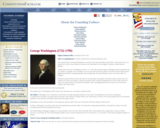
Read information about the "Founding Fathers" of the United States of America, including George Washington, James Madison, Thomas Jefferson, John Adams, Benjamin Franklin, Alexander Hamilton, George Mason, Gouverneur Morris, Roger Sherman, James Wilson, and Edmund Randolph.
- Subject:
- History
- Social Science
- Social Studies
- Material Type:
- Reading
- Provider:
- ConstitutionFacts.com
- Date Added:
- 01/03/2023

On September 17, 1787, the Constitutional Convention came to a close in the Assembly Room of Independence Hall in Philadelphia, Pennsylvania. There were seventy individuals chosen to attend the meetings with the initial purpose of amending the Articles of Confederation.
- Subject:
- History
- Social Science
- Social Studies
- Material Type:
- Reading
- Provider:
- ConstitutionFacts.com
- Date Added:
- 01/03/2023

Students examine elements of Abraham Lincoln's life in this lesson based on the PBS series History Detectives. Using primary source documents, students should have a better understanding of who Lincoln was as a person and leader.
- Subject:
- Social Science
- Material Type:
- Lesson Plan
- Provider:
- PBS Learning Media
- Date Added:
- 03/22/2024

Explore a gallery of images about Abraham Lincoln, his wife Mary Todd, and his assassination. Abraham Lincoln was the 16th President of the United States, the first president from the Republican Party, and the leader of the country during the American Civil War. Lincoln’s firm anti-slavery position led to his Emancipation Proclamation, which declared that slaves living in southern, rebel states were free. His oratorical and writing skills, and firm belief in preserving the future of the Union of the United States, appealed to the best of American ideals. Lincoln served as president from 1861-1865. He was assassinated by John Wilkes Booth in Ford’s Theatre in Washington DC on April 14, 1865.
- Subject:
- Social Science
- Material Type:
- Primary Source
- Provider:
- PBS Learning Media
- Date Added:
- 03/22/2024
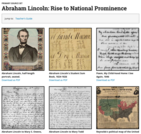
Primary Source Set from the Library of Congress about Abraham Lincoln's political timeline and career
- Subject:
- Social Science
- Material Type:
- Primary Source
- Provider:
- Library of Congress
- Date Added:
- 11/09/2023

This inquiry kit features Library of Congress sources and focuses on four of Abraham Lincoln's key speeches.
- Subject:
- Social Science
- Material Type:
- Primary Source
- Provider:
- PBS Learning Media
- Date Added:
- 03/22/2024
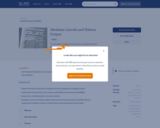
The "Great Writ" or habeas corpus has been an essential civil liberty guaranteed since Magna Carta. In listing powers denied to Congress, the Constitution notes that "The privilege of the writ of habeas corpus shall not be suspended, unless when in cases of rebellion or invasion the public safety may require it." In 1861, Abraham Lincoln invoked this power of Congress—which was not in session—to suspend habeas corpus in certain areas. The next year, as he believed the civil justice system was inadequate to deal with the rebellion, he expanded the suspension throughout the United States and established military tribunals to try citizens charged with disloyalty. In this lesson, students explore Lincolnâ"s suspension of habeas corpus and constitutional issues surrounding it.
- Subject:
- Social Science
- Social Studies
- Material Type:
- Lesson Plan
- Provider:
- Bill of Rights Institute
- Date Added:
- 09/12/2022
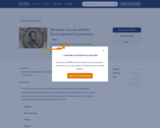
Presidents Buchanan, Lincoln, and Johnson believed that the Constitution protected the institution of slavery. Lincoln came to the conclusion that, in order to preserve the Constitution and the Union it created, he must apply a new understanding of the principles on which the nation was built. The time had come to bring the nationâ"s policies in line with the of the Declaration of Independence that "…all men are created equal…" In this lesson, students will analyze Abraham Lincolnâ"s views on slavery and the Constitution as evidenced in the Emancipation Proclamation.
- Subject:
- Social Science
- Social Studies
- Material Type:
- Lesson Plan
- Provider:
- Bill of Rights Institute
- Date Added:
- 09/12/2022

This lesson traces Lincoln's political life during a time of constitutional crisis. It examines Lincoln's ideas and decisions regarding slavery and the use of presidential power to preserve the Union.
- Subject:
- Social Science
- Social Studies
- Material Type:
- Lesson Plan
- Provider:
- Center for Civic Education
- Date Added:
- 09/12/2022
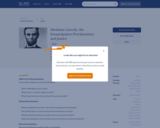
In this lesson, students will learn about Abraham Lincolnâ"s Emancipation Proclamation. Students will specifically learn about how Lincolnâ"s actions conform to the idea of justice and how they can apply this idea into actions in their own lives.
- Subject:
- Social Science
- Social Studies
- Material Type:
- Lesson Plan
- Provider:
- Bill of Rights Institute
- Date Added:
- 09/12/2022

In Abrams v. United States (1919), the U.S. Supreme Court reinforced the “clear and present danger” test for restricting freedom of speech, previously established in Schenck v. United States, and upheld several convictions under the Sedition Act of 1918 (an amendment to the Espionage Act of 1917). Abrams is best known for its famous dissent, written by Justice Oliver Wendell Holmes, who had established the “clear and present danger” test just eight months prior.
- Subject:
- Social Science
- Social Studies
- Material Type:
- Reading
- Provider:
- ThoughtCo
- Provider Set:
- Constitution
- Author:
- Elianna Spitzer
- Date Added:
- 07/10/2024

USA.gov page with information about absentee voting and voting by mail
- Subject:
- Social Science
- Material Type:
- Reading
- Provider:
- USAGov
- Date Added:
- 07/03/2024
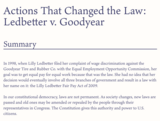
This lesson is based on the Annenberg Classroom video âA Call to Act: Ledbetter v. Goodyear Tire and Rubber Co.,â which tells the law-changing story behind the Lilly Ledbetter Fair Pay Act of 2009. Students gain insight into law-making process, consider how statutory decisions made by the Supreme Court can prompt better laws, and learn about the rights and responsibilities they will have when they enter the workforce.
The estimated time for this lesson is four days.
- Subject:
- Social Science
- Social Studies
- Material Type:
- Lesson Plan
- Provider:
- Annenberg Foundation
- Provider Set:
- Annenberg Classroom
- Date Added:
- 08/11/2022
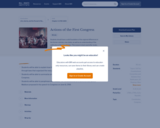
Students should have a solid foundation of the regional differences in the former colonies, now states, as well as an understanding of the ratification of the Constitution. This Lesson is best used after students have read The Constitutional Convention and The Ratification Debate on the Constitution Narratives in Chapter 3. The James Madison and the Bill of Rights Narrative in Chapter 4 can be used as background for the Lesson or can be assigned as homework after the Lesson to reinforce main ideas.
- Subject:
- Social Science
- Social Studies
- Material Type:
- Lesson Plan
- Provider:
- Bill of Rights Institute
- Date Added:
- 09/12/2022

Active listening is really the application of the Golden Rule and perhaps the most critical skill for resolving conflict. To know how to listen to someone else, think about how you would want to be listened to. While the ideas are largely intuitive, it might take some practice to develop (or re-develop) the skills.
- Subject:
- Social Science
- Material Type:
- Activity/Lab
- Provider:
- Conflict Resolution Education
- Date Added:
- 11/09/2023